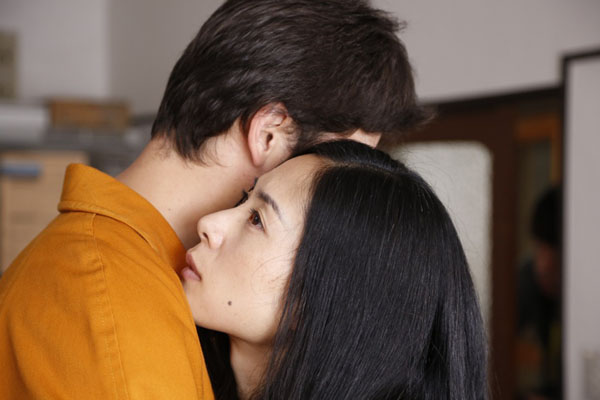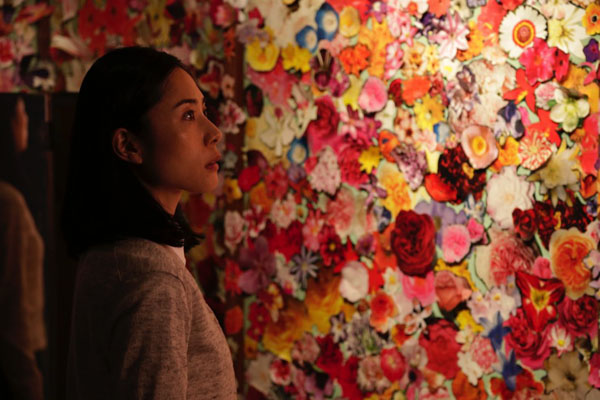“A corrective to Sea of Trees’ inane treatment of death and supernatural, Kiyoshi Kurosawa’s sweet, strange Un Certain Regard entry Journey to the Shore (Grade: B/B-) invents a whole mythology of the afterlife without using a single special effect,” writes Ignatiy Vishnevetsky at the AV Club. “One evening, piano teacher Mizuki (Eri Fukatsu) turns around to find her husband Yusuke (Tadanobu Asano), missing for three years, standing in her kitchen. ‘I’m dead,’ he says, explaining that he drowned himself in the ocean, and that it’s taken him this long to walk back to her. Now he needs her to help some of the people who treated him kindly along the way…. Kurosawa is fundamentally a long-take classicist, crafting drama and tension through arrangements of characters within the frame.” Here, he “goes for creepy and jagged, slipping in bits of gentle humor, and getting a lot of mileage out of the old trick of panning back to reveal a character who wasn’t there before.”
But for Mike D’Angelo, dispatching to the Dissolve, Journey is “almost surreally boring… Kurosawa has always been a master of foreboding creepiness (see Pulse and Cure), so a ghost story ought to be right up his alley…. In this film, ghosts are no different from living humans (apart from being dead)—they can be seen by everyone, are in no way frightening, and really just want nothing more than to provide comfort and reassurance to the loved ones they’ve left behind. It’s so relentlessly placid, tasteful, and minor-key that I longed for Peter Venkman and friends to show up with proton packs. Cross the streams. For the love of all that’s holy, cross the streams!!!“
For Variety‘s Maggie Lee, this is “Kurosawa’s competent return to human drama in the vein of Tokyo Sonata, albeit with a spiritual dimension. Traversing East Japan from small towns to remote hamlets, the film’s winding, episodic form ultimately conveys a blindingly obvious message, but the way in which its motley characters work through feelings of loss, regret and acceptance have a hushed, timorous sentiment that’s uniquely Japanese…. Compared with the helmer’s previous work, the clunky Freudian horror-fairy-tale mashup Real, Journey is less ambitious but more heartfelt, never straining to be novel or profound.”
The Hollywood Reporter‘s David Rooney disagrees: “While admirers of the director’s work might sit still for the glacial pacing, the overlong film becomes steadily less involving after a promising setup, trading mystery for a sentimental vein fed by its sudsy romantic score.” And “while Fukatsu and Asano (who worked with Kurosawa in Bright Future) are both fine, their characters are not distinctive enough to make the conclusion particularly moving.”
“Kurosawa’s overlong afterlife love story seems undecided whether it belongs in the arthouse or on afternoon TV, and it’s a conflict that mars a rosy premise,” finds Screen‘s Lee Marshall.
Updates, 5/19: “Journey to the Shore is one of the few unquantifiable movies premiering here on the Croisette, a truly odd and quite lovely ghost story,” writes Daniel Kasman in the Notebook. “This episodic structure recalls Kurosawa’s last excellent work, the miniseries Penance, and as in that film he here displays a incredibly subtly tonal range, segueing almost imperceptibly from intonations of melancholy art house to horror film, comedy, low key rural drama, and sentimental romance. The overall sensibility is sweetly unsettling, a fitting result for this rare heir to Georges Franju (Eyes without a Face), especially during the eerily climatic resolution to each of the hauntings.”
Grantland‘s Wesley Morris: “Romantic? Sort of, but also at least three journeys too long.”
Update, 5/22: “Journey to the Shore is more wistful and plaintive than strictly unnerving, with an emotional force that edges in like an afternoon shadow,” writes Manohla Dargis for the New York Times. “One of the most meaningfully beautiful and moving images that I’ve seen in the festival so far is of a darkened bedroom wall that slowly brightens to reveal a mural of vibrantly hued flowers. The house belongs to an old man, who, you learn through Mr. Kurosawa’s spare dialogue, was cruel to his long-gone wife. Now the old man spends his free time cutting out pictures of flowers, as if collecting blooms for a bouquet that will convey the longing and regret he can no longer express to his wife.”
Update, 5/25: “Can I state definitively that Journey to the Shore is boring?” wonders Jessica Kiang at the Playlist. “No, but I can say I was bored by it, stiffer than a corpse at the height of rigor mortis. And then it won the Un Certain Regard award for Best Director, which just goes to show you what I know.”
Update, 5/27: Back in the Notebook, Danny Kasman takes part in a roundtable discussion with Kurosawa.
Update, 5/29: In the Japan Times, Mark Schilling argues that Kurosawa “also deserves a prize from the Japanese film industry for single-handedly turning its presence at the world’s most prestigious film festival from a vague embarrassment to a cause for celebration—at least among the Japanese media.”
Cannes 2015 Index. For news and tips throughout the day every day, follow @KeyframeDaily. Get Keyframe Daily in your inbox by signing in at fandor.com/daily.





